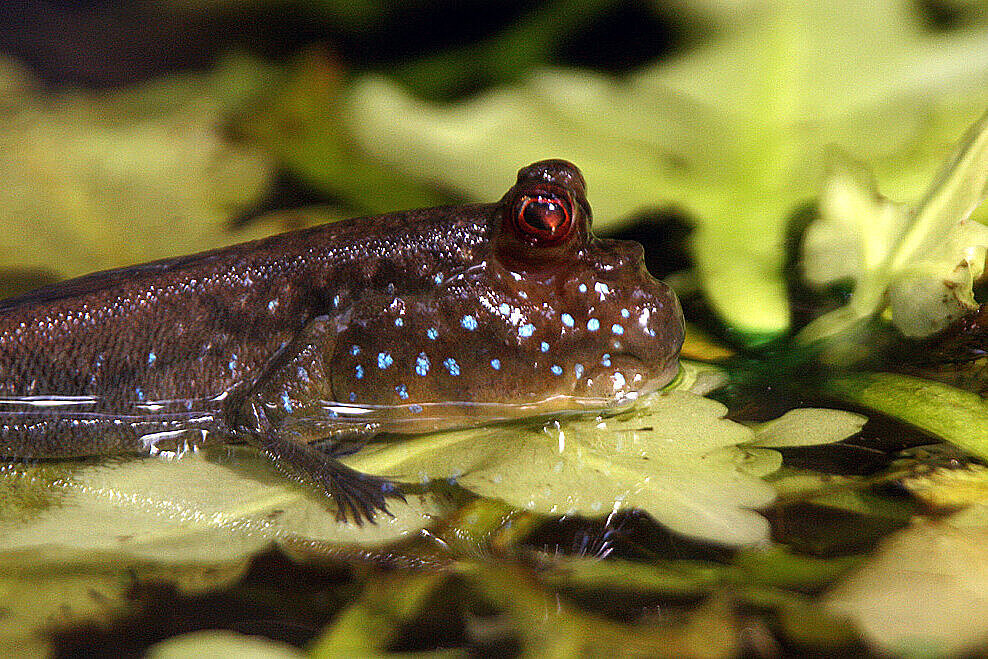
The Atlantic Mudskipper has a long body and an inferior mouth used for benthic feeding. They are equipped with two dorsal fins with the posterior dorsal fin shortened/elongated, and an elongated anal fin. Atlantic Mudskippers have a rounded caudal fin a shape ill-equipped for high swimming speeds which wouldn’t be necessary since they prefer terrestrial land most of the time. The Atlantic Mudskippers can be uniquely identified with their silver line and blue spots.
Sexual Dimorphism

Nigerian Characteristics and the Possibility of more.

| Measurement | Average Length (cm) ± Standard Deviation |
| Head Width | 11.41±1.15 |
| Snout Length | 9.84±1.11 |
| Eye Diameter | 0.071±0.24 |
| Body Depth | 1.59±1.13 |
| Pre-Dorsal Length | 3.29±0.53 |
| Caudal Peduncle Length | 1.95±0.41 |
| First Dorsal Fin Length | 1.46±0.50 |
| Second Dorsal Fin Length | 1.90±0.38 |
| Anal Fin Length | 1.03±0.25 |
| Caudal Fin Length | 1.80±0.45 |
| Pectoral Fin Length | 1.96±0.41 |
| Head Length | 3.01±0.69 |
| Total Length | 11.41±1.15 |
| Standard Length | 9.48±1.11 |
(Sokefun O et all, 2022)
In 2022 a research team took measurements of a collection of 100 Atlantic Mudskippers in Nigeria. Mudskippers have been reported as generally cryptic with reports of its phenotypically variability and even convergent evolution referring to them as “borderline organisms”. The measurements of the study were made to see if there are any consistent morphological subdivisions within the Nigerian Atlantic Mudskipper population that would start as the basis for any different species. The results didn’t show any evidence so they are the subject of barcode sampling in the search of molecular speciation.
Special Eyes
Video explaining the eye movement of mudskippers, pulling them into their heads to keep them moist as a type of “blinking”.
Walking on Land

Mudskippers are able to move on land by moving their unique pectoral fins in front of them and propelling the rest of the body forward in a slow gait. The use of an intro-fin joint created by relatively long radials within their stiff pectoral fins, allow them to touch the ground freely without impediment from their long bodies. When the elongated pectoral fins are on the ground with the help of specialized fin muscles their retraction creates enough force to vault their bodies starting from their heads off the ground to land forward. This type of movement is often referred to as “crutching”. Mudskippers are not only able to walk on the surface but by expanding the Atlantic Mudskipper are able to use their unfused mucous coated pelvic fins by expanding them on flat surfaces, giving them the ability to climb up vertical surfaces as well. Especially mangroves. (Though not all Mudskippers have this feature). Not only are their pectoral and pelvic fins key parts of their terrestrial movement, their caudal fins is also a key body part, when the mudskipper lays on it sides it can lift their tails up towards their heads and push off against the ground jumping them off into the air, primarily to attract mates.




However there is more going on with their terrestrial movement. Mudskippers have been shown to adjust their bodies in response to the type of substrate their own, especially the difficult ones like mud and sand that most other tetrapods find difficult as well as if they’re “crutching” at an incline. When the Mudskipper is moving on substrate that is at an incline or deformable (sand and mud), their pectoral fins become more spread out, increasing surface contact with the ground. This strategy serves multiple purposes; increasing friction, reducing submersion into the substance, and saving energy. For a similar purpose when on sand and mud they also increase not only the area of contact, but also the length of contact on the ground to maintain its position and save energy. On mud specifically and on their rays seemed to be bent down to what was referred to as “gripping” which may help prevent slipping as long as extending the contact time. On inclines they lower their mass on their substance, getting into a crouched position for stability.
However, Sand was a more unique substance. The Atlantic Mudskippers in this study didn’t land on their pelvic fins, instead “bellyflopping” when they landed. On sand they performed high spinal flexion bending the top side of their posterior to their dorsal fin. Something seemingly unique to sand, the reasons for this is guessed to be to reduce friction and improve displacement.

Can they Swim?
Mudskippers are able to swim but they lack a swim bladder.